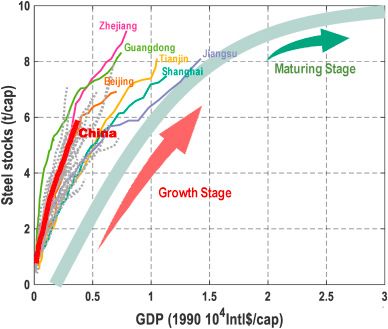Song, Lulu; Wang, Peng; Xiang, Keying; Chen, Wei-Qiang*;
Journal of Environmental Management 2020 271, 111035. DOI: 10.1016/j.jenvman.2020.111035
Abstract
Human-made material stocks promote the economic prosperity, while the consumption, maintenance, and operation of them have led to adverse environmental impacts. Decoupling materials stocks from economic growth is a key strategy for relieving environmental pressures and achieving sustainable development. China’s unprecedented development offers a unique opportunity for uncovering the relationship between in-use stocks and economic growth. In this study, we analyzed the regional disparity of in-use steel stocks estimated by bottom-up accounting method during 1978-2018 in 31 provinces in mainland China, explored the stocks productivity on provincial and regional scale, and conducted a decoupling analysis of in-use steel stocks with economic growth. The results showed that there was a huge disparity among the provincial total steel stocks, per-capita steel stocks, and stocks density. Some provinces, e.g. Beijing, Tianjin, and Shanghai, that had the highest stocks density had comparatively lower per-capita steel stocks and total steel stocks, indicating higher share of in-use steel stocks and lower material intensive economic structure. In-use steel stocks in China showed no clear signs of saturation or flatten off pattern although their growth rate declined recently. An increase in steel stocks productivity was found during 1978-2018, which means relative decoupling of in-use steel stocks from economic growth, but still far away from absolute decoupling. The dematerialization pattern revealed in this study deepens our understanding of material-economy interactions. Policy implications for dematerialization transition should focus on developing compact cities, prolonging the lifespan of products, and advancing technological development.
Per-capita steel stocks versus per-capita GDP PPP on national and provincial scale. The thick grey-green line is a fitted logistic growth curve used to estimate the contemporary steel stocks in industrialized countries constructed by Müller et al. (2011). (For interpretation of the references to colour in this figure legend, the reader is referred to the Web version of this article.)
